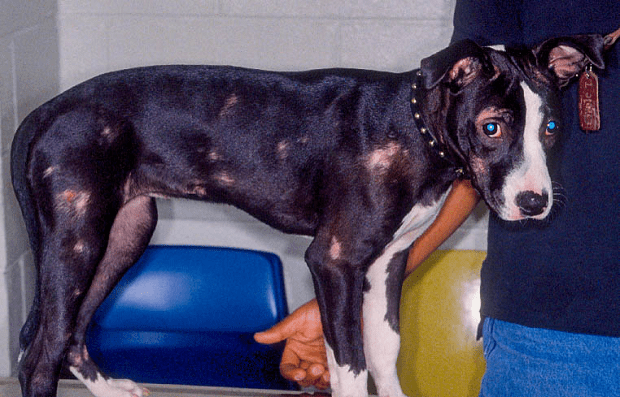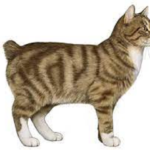
Demodex mites are normal residents of the skin in virtually all mammal species. For the most part, they live in the hair follicles, don’t cause issues and are not able to spread to another host, much less cross to another species. The cat’s main mite is called Demodex cati. There are two other demodex mites that the cat can have that are more likely to present problems: Demodex gatoi and a newly found mite that is currently unnamed and has a fatter body and a shorter tail.
These latter two Demodex mite species are contagious to other cats an readily cause skin disease. The nature of the skin disease with either type of mite infection can be quite variable ranging from over-grooming (also called fur mowing) to raw weepy eosinophilic granuloma complexlesions to the dry seed-like scabs commonly referred to as miliary dermatitis. When cats have demodex overgrowth, it is usually itchy.
Two Types of Mange, Three Types of Mange Mite
Demodex cati, as mentioned, lives inside hair follicles while Demodex gatoi and the unnamed mite live more superficially in the skin. For all intents and purposes, the unnamed mite has biology similar to that of Demodex gatoi and appears to respond to the same therapies so from here on out we will discuss feline demodicosis as either of the “cati” type or the “gatoi” type.

Diagnosis
Most of the time diagnosis is confirmed with a skin scraping or similar skin sampling technique. Occasionally mites are found during examination of a fecal sample because itchy cats will groom and swallow their skin mites (especially in the event of Demodex gatoi infection where the mites are superficial in the skin and readily licked away). If skin scrapes are negative for an itchy cat, a fecal sample is a good way to cover all bases. It is important to determine which mite is present as the treatment and consequences will be very different

When disease is caused by Demodex cati the mites are fairly easy to find. With Demodex gatoi, a small number of mites can lead to a great deal of inflammation. The smaller numbers make them harder to find. Sometimes we must go by response to treatment to diagnose Demodex gatoi as they are elusive.
Treatment for Demodex cati
Because Demodex cati lives deeper in the hair follicle, it is sensitive to treatment in a way that Demodex gatoi is not. Effective treatments are topical fluralaner (Bravecto®), daily oral ivermectin or milbemycin or one can use lime sulfur dips once or twice a week for six dips total. Dipping is labor intensive as well as smelly so it is nice to have more convenient alternatives. Further good news is that since Demodex cati does not create a contagious disease, treating all the cats in the home is unnecessary.
The bad news is that a Demodex cati infection suggests a problem with the cat’s immune system and it is important to seek a second disease that might result in immune suppression. Expect further testing to be needed.
Treatment for Demodex gatoi
This species of mite is considered to be contagious among cats so if it is confirmed or strongly suspected in one cat, then all the cats in the household must be treated. Treatment of choice involves a series of six dips of two-percent lime sulfur given at weekly intervals. The cat must soak in the dip, which regrettably stinks of rotten eggs, for at least five minutes and must air dry afterwards. The dip not only smells bad but will stain fabric and jewelry and can temporarily impart a yellow tinge to white fur. Because of these unpleasant factors and because many cats are not amenable to being quietly bathed, these dips are frequently performed in the veterinary hospital. It should be noted that the dips are also very drying to the skin so that conditioners may be needed by the third week to prevent dandruff.
As noted, if Demodex gatoi has been confirmed or is strongly suspected, all cats in the home must be treated. There is temptation not to treat cats that are not showing symptoms but it is possible for cats to carry Demodex gatoi without showing symptoms, so they all must be treated to avoid the potential for a carrier cat reinfecting the others. If no response in the skin condition is seen after three weekly dips, however, and Demodex gatoi was never actually confirmed, this would suggest that another disease is causing the problem and dipping may be abandoned.
Dipping is labor-intensive and unpleasant for all the reasons noted above. It would be great if an oral treatment such as ivermectin could be used. Unfortunately, because Demodex gatoi lives on the surface of the skin, ivermectin cannot reach it and it is not a reliable treatment. Fluralaner (Bravecto®) and other isoxazoline flea products have been miraculous for canine demodectic mange and it is hoped that they will be useful for the feline situation, but research is lacking at this time and dipping remains treatment of choice.
Treatment of Cats Testing Negative for Mites
It is not unusual for cats to test negative for mites for the reasons already described. For these cats, dipping can be performed on a trial basis. Dips are given once a week for three weeks. If the cat is notably improved after this time frame, then three more weekly dips should be performed. The other cats in the home should be dipped for six dips each as well. Response to lime sulfur dip is seen in conditions other than demodicosis, so you cannot necessarily infer demodicosis from results. That said, other conditions that might respond, ringworm for example, would likely necessitate lime sulfur treatment of the entire household cat population anyway.


